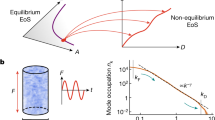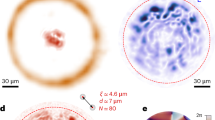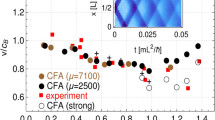Abstract
A central concept in the modern understanding of turbulence is the existence of cascades of excitations from large to small length scales, or vice versa. This concept was introduced in 1941 by Kolmogorov and Obukhov1,2, and such cascades have since been observed in various systems, including interplanetary plasmas3, supernovae4, ocean waves5 and financial markets6. Despite much progress, a quantitative understanding of turbulence remains a challenge, owing to the interplay between many length scales that makes theoretical simulations of realistic experimental conditions difficult. Here we observe the emergence of a turbulent cascade in a weakly interacting homogeneous Bose gas—a quantum fluid that can be theoretically described on all relevant length scales. We prepare a Bose–Einstein condensate in an optical box7, drive it out of equilibrium with an oscillating force that pumps energy into the system at the largest length scale, study its nonlinear response to the periodic drive, and observe a gradual development of a cascade characterized by an isotropic power-law distribution in momentum space. We numerically model our experiments using the Gross–Pitaevskii equation and find excellent agreement with the measurements. Our experiments establish the uniform Bose gas as a promising new medium for investigating many aspects of turbulence, including the interplay between vortex and wave turbulence, and the relative importance of quantum and classical effects.
This is a preview of subscription content, access via your institution
Access options
Subscribe to this journal
Receive 51 print issues and online access
$199.00 per year
only $3.90 per issue
Buy this article
- Purchase on Springer Link
- Instant access to full article PDF
Prices may be subject to local taxes which are calculated during checkout



Similar content being viewed by others
References
Kolmogorov, A. N. The local structure of turbulence in incompressible viscous fluid for very large Reynolds numbers. Dokl. Akad. Nauk SSSR 30, 299–303 (1941)
Obukhov, A. On the distribution of energy in the spectrum of turbulent flow. Dokl. Akad. Nauk SSSR 32, 22–24 (1941)
Sorriso-Valvo, L. et al. Observation of inertial energy cascade in interplanetary space plasma. Phys. Rev. Lett. 99, 115001 (2007)
Mösta, P. et al. A large-scale dynamo and magnetoturbulence in rapidly rotating core-collapse supernovae. Nature 528, 376–379 (2015)
Hwang, P. A., Wang, D. W., Walsh, E. J., Krabill, W. B. & Swift, R. N. Airborne measurements of the wavenumber spectra of ocean surface waves. Part I: spectral slope and dimensionless spectral coefficient. J. Phys. Oceanogr. 30, 2753–2767 (2000)
Ghashghaie, S., Breymann, W., Peinke, J., Talkner, P. & Dodge, Y. Turbulent cascades in foreign exchange markets. Nature 381, 767–770 (1996)
Gaunt, A. L., Schmidutz, T. F., Gotlibovych, I., Smith, R. P. & Hadzibabic, Z. Bose-Einstein condensation of atoms in a uniform potential. Phys. Rev. Lett. 110, 200406 (2013)
Paoletti, M. S. & Lathrop, D. P. Quantum turbulence. Annu. Rev. Condens. Matter Phys. 2, 213–234 (2011)
Chesler, P. M., Liu, H. & Adams, A. Holographic vortex liquids and superfluid turbulence. Science 341, 368–372 (2013)
Maurer, J. & Tabeling, P. Local investigation of superfluid turbulence. Europhys. Lett. 43, 29–34 (1998)
Walmsley, P. M. & Golov, A. I. Quantum and quasiclassical types of superfluid turbulence. Phys. Rev. Lett. 100, 245301 (2008)
Bradley, D. et al. Direct measurement of the energy dissipated by quantum turbulence. Nat. Phys. 7, 473–476 (2011)
Ganshin, A. N., Efimov, V. B., Kolmakov, G. V., Mezhov-Deglin, L. P. & McClintock, P. V. E. Observation of an inverse energy cascade in developed acoustic turbulence in superfluid helium. Phys. Rev. Lett. 101, 065303 (2008)
Abdurakhimov, L. V., Brazhnikov, M. Y., Levchenko, A. A., Remizov, I. & Filatov, S. Turbulent capillary cascade near the edge of the inertial range on the surface of a quantum liquid. JETP Lett. 95, 670–679 (2012)
Kolmakov, G. V., McClintock, P. V. E. & Nazarenko, S. V. Wave turbulence in quantum fluids. Proc. Natl Acad. Sci. USA 111, 4727–4734 (2014)
Kagan, Y. & Svistunov, B. V. Evolution of correlation properties and appearance of broken symmetry in the process of Bose–Einstein condensation. Phys. Rev. Lett. 79, 3331–3334 (1997 ) ; erratum 80, 892 (1998)
Nore, C., Abid, M. & Brachet, M. E. Kolmogorov turbulence in low-temperature superflows. Phys. Rev. Lett. 78, 3896–3899 (1997)
Berloff, N. G. & Svistunov, B. V. Scenario of strongly nonequilibrated Bose–Einstein condensation. Phys. Rev. A 66, 013603 (2002)
Kobayashi, M. & Tsubota, M. Kolmogorov spectrum of superfluid turbulence: numerical analysis of the Gross–Pitaevskii equation with a small-scale dissipation. Phys. Rev. Lett. 94, 065302 (2005)
Proment, D., Nazarenko, S. & Onorato, M. Quantum turbulence cascades in the Gross-Pitaevskii model. Phys. Rev. A 80, 051603 (2009)
Reeves, M. T., Billam, T. P., Anderson, B. P. & Bradley, A. S. Inverse energy cascade in forced two-dimensional quantum turbulence. Phys. Rev. Lett. 110, 104501 (2013)
Henn, E. A. L., Seman, J. A., Roati, G., Magalhães, K. M. F. & Bagnato, V. S. Emergence of turbulence in an oscillating Bose–Einstein condensate. Phys. Rev. Lett. 103, 045301 (2009)
Neely, T. W. et al. Characteristics of two-dimensional quantum turbulence in a compressible superfluid. Phys. Rev. Lett. 111, 235301 (2013)
Kwon, W. J., Moon, G., Choi, J., Seo, S. W. & Shin, Y. Relaxation of superfluid turbulence in highly oblate Bose-Einstein condensates. Phys. Rev. A 90, 063627 (2014)
Tsatsos, M. C. et al. Quantum turbulence in trapped atomic Bose-Einstein condensates. Phys. Rep. 622, 1–52 (2016)
Gotlibovych, I. et al. Observing properties of an interacting homogeneous Bose–Einstein condensate: Heisenberg-limited momentum spread, interaction energy, and free-expansion dynamics. Phys. Rev. A 89, 061604 (2014)
Schmidutz, T. F. et al. Quantum Joule–Thomson effect in a saturated homogeneous Bose gas. Phys. Rev. Lett. 112, 040403 (2014)
Zakharov, V. E., L’Vov, V. S. & Falkovich, G. Kolmogorov Spectra of Turbulence (Springer, 1992)
Pitaevskii, L. P. & Stringari, S. Bose–Einstein Condensation and Superfluidity Ch. 12 (Oxford Univ. Press, 2016)
Stenger, J. et al. Bragg spectroscopy of a Bose–Einstein condensate. Phys. Rev. Lett. 82, 4569–4573 (1999)
Acknowledgements
We thank G. V. Shlyapnikov, B. Svistunov, S. Stringari, N. R. Cooper, J. Dalibard, M. J. Davis, R. J. Fletcher, M. W. Zwierlein, K. Fujimoto and M. Tsubota for discussions, and C. Eigen for experimental assistance. This work was supported by AFOSR, ARO, DARPA OLE, EPSRC (Grant No. EP/N011759/1) and ERC (QBox). The GeForce GTX TITAN X used for the numerical simulations was donated by the NVIDIA Corporation. N.N. and A.L.G. acknowledge support from Trinity College, Cambridge; R.P.S. acknowledges support from the Royal Society.
Author information
Authors and Affiliations
Contributions
N.N. initiated the project, and took and analysed the data. A.L.G. wrote the code for the numerical simulations and analysed the results. Z.H. supervised the project. All authors contributed extensively to the interpretation of the data and the writing of the manuscript.
Corresponding author
Ethics declarations
Competing interests
The authors declare no competing financial interests.
Extended data figures and tables
Extended Data Figure 1 Momentum distributions from TOF and Bragg techniques.
a, b, Comparison of n1D(kz) obtained using TOF expansion (solid lines) and Bragg spectroscopy (points), in the case of the initial, quasi-pure BEC (a) and the turbulent gas (b). The red dashed line in a corresponds to the Heisenberg-limited momentum distribution. All distributions are normalized to unity ( ), without any adjustable parameters.
), without any adjustable parameters.
Extended Data Figure 2 Turbulent cascade in numerical simulations.
a, In-plane momentum distribution  for various shaking times ts. b, Ratio of the compressible- (
for various shaking times ts. b, Ratio of the compressible- ( c) to incompressible-flow (
c) to incompressible-flow ( i) components of the fluid-dynamical kinetic energy, with the colours corresponding to the shaking times in a. The simulation parameters for both panels are N = 8 × 104, shaking frequency ω/(2π) = 9 Hz and shaking amplitude ΔU = μ.
i) components of the fluid-dynamical kinetic energy, with the colours corresponding to the shaking times in a. The simulation parameters for both panels are N = 8 × 104, shaking frequency ω/(2π) = 9 Hz and shaking amplitude ΔU = μ.
Rights and permissions
About this article
Cite this article
Navon, N., Gaunt, A., Smith, R. et al. Emergence of a turbulent cascade in a quantum gas. Nature 539, 72–75 (2016). https://doi.org/10.1038/nature20114
Received:
Accepted:
Published:
Issue Date:
DOI: https://doi.org/10.1038/nature20114
This article is cited by
-
Universal equation of state for wave turbulence in a quantum gas
Nature (2023)
-
Accurate holographic light potentials using pixel crosstalk modelling
Scientific Reports (2023)
-
Rotating quantum wave turbulence
Nature Physics (2023)
-
Energy Transfer of the Gross-Pitaevskii Turbulence in Weak-Wave-Turbulence and Strong-Turbulence Ranges
Journal of Low Temperature Physics (2023)
-
Observation of vortices and vortex stripes in a dipolar condensate
Nature Physics (2022)
Comments
By submitting a comment you agree to abide by our Terms and Community Guidelines. If you find something abusive or that does not comply with our terms or guidelines please flag it as inappropriate.



